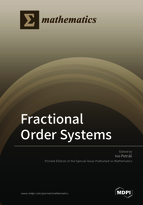Fractional Order Systems
A special issue of Mathematics (ISSN 2227-7390).
Deadline for manuscript submissions: closed (30 April 2019) | Viewed by 27776
Special Issue Editor
Interests: fractional calculus and its applications; dynamical systems; chaos theory; control theory; mathematical modelling; simulations; process control; automation; signal processing
Special Issues, Collections and Topics in MDPI journals
Special Issue Information
Dear Colleagues,
It is well known that fractional calculus is recognized since the regular calculus with the first written reference dated in September 1695 in letter from Leibniz to L’Hospital. Nowadays, the fractional calculus has a wide area of applications, for example, physics, chemistry, bioengineering, chaos theory, control systems engineering, and many others. In all those applications we deal, in general, with fractional order systems. Moreover, the fractional calculus plays an important role even in the complex systems and therefore allows us to use a better description of some real-world phenomena. Based on this fact, the fractional order systems are ubiquitous as well as whole real world around us is fractional, not integer one. Due to this reason it is so urgent consider almost all systems as the fractional order systems.
This Special Issue is focused on the theory and multidisciplinary applications of fractional order systems in science and engineering, and will accept only high-quality survey, and/or original research papers.
Prof. Dr. Ivo Petráš
Guest Editor
Manuscript Submission Information
Manuscripts should be submitted online at www.mdpi.com by registering and logging in to this website. Once you are registered, click here to go to the submission form. Manuscripts can be submitted until the deadline. All submissions that pass pre-check are peer-reviewed. Accepted papers will be published continuously in the journal (as soon as accepted) and will be listed together on the special issue website. Research articles, review articles as well as short communications are invited. For planned papers, a title and short abstract (about 100 words) can be sent to the Editorial Office for announcement on this website.
Submitted manuscripts should not have been published previously, nor be under consideration for publication elsewhere (except conference proceedings papers). All manuscripts are thoroughly refereed through a single-blind peer-review process. A guide for authors and other relevant information for submission of manuscripts is available on the Instructions for Authors page. Mathematics is an international peer-reviewed open access semimonthly journal published by MDPI.
Please visit the Instructions for Authors page before submitting a manuscript. The Article Processing Charge (APC) for publication in this open access journal is 2600 CHF (Swiss Francs). Submitted papers should be well formatted and use good English. Authors may use MDPI's English editing service prior to publication or during author revisions.
Keywords
- Fractional calculus and its applications
- Fractional differential equations
- Fractional order dynamical systems
- Fractional order control
- Fractional nonlinear and chaotic systems






